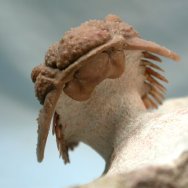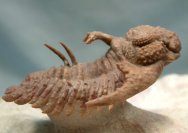|  This
Hoplolichas furcifer specimen is testament to the creativity of adaptation
by means of natural selection, as well as to the art of trilobite preparators.
The spinous nature of the exoskeleton of this trilobite is a common phenotypic
trait of members of Order
Lichida (as well as Order Odontopleurida that was formerly Lichida Superfamily
Odontopleuroidea); of course, spines are a common feature of trilobites
from their earliest origins, and appear in diverse and elaborate displays.
The selective pressure for nature’s spinous creativity was of course
the This
Hoplolichas furcifer specimen is testament to the creativity of adaptation
by means of natural selection, as well as to the art of trilobite preparators.
The spinous nature of the exoskeleton of this trilobite is a common phenotypic
trait of members of Order
Lichida (as well as Order Odontopleurida that was formerly Lichida Superfamily
Odontopleuroidea); of course, spines are a common feature of trilobites
from their earliest origins, and appear in diverse and elaborate displays.
The selective pressure for nature’s spinous creativity was of course
the  perpetual evolutionary
arms race between predator and prey. The 100 sharp spines of this
trilobite would have been a nasty morsel to even some of the newer reef
system predators of the Ordovician seas, such as fish with jaws. The
Hypostome that served as a support for the mouthparts is prepared and
clearly visible in this specimen. perpetual evolutionary
arms race between predator and prey. The 100 sharp spines of this
trilobite would have been a nasty morsel to even some of the newer reef
system predators of the Ordovician seas, such as fish with jaws. The
Hypostome that served as a support for the mouthparts is prepared and
clearly visible in this specimen.
These images
were taken some 20 years ago and have since propagated far and wide on
the Internet, as well as  those
of Hoplolichas
tricuspidatus, Hoplolichas
plautini and Metopolichas
verrucosus. It is not easy to miss the eye lenses that very closely
resemble schizochroal
eyes (with far fewer lenses than holochroal
eyes and each lens with an individual cornea) that are found exclusively
in trilobites of Order
Phacopid, Suborder Phacopina. However, the number of lenses in this
Hoplolichas are far fewer than the typical few hundred to 700 found in
Phacopina (albeit, there are some
Phacopina with greatly reduced number of lenses, apparently an evolutionary
adaptation). It is hardly unusual for the crystal lenses to be preserved
in magnificent detail in Phacopida (above right), and the Hoplolichas
eyes seen here have been manufactured accordingly. More recently prepared
Hoplolichas sport the ostensibly correct holochroal versions with thousands
of tiny lenses, as shown above. those
of Hoplolichas
tricuspidatus, Hoplolichas
plautini and Metopolichas
verrucosus. It is not easy to miss the eye lenses that very closely
resemble schizochroal
eyes (with far fewer lenses than holochroal
eyes and each lens with an individual cornea) that are found exclusively
in trilobites of Order
Phacopid, Suborder Phacopina. However, the number of lenses in this
Hoplolichas are far fewer than the typical few hundred to 700 found in
Phacopina (albeit, there are some
Phacopina with greatly reduced number of lenses, apparently an evolutionary
adaptation). It is hardly unusual for the crystal lenses to be preserved
in magnificent detail in Phacopida (above right), and the Hoplolichas
eyes seen here have been manufactured accordingly. More recently prepared
Hoplolichas sport the ostensibly correct holochroal versions with thousands
of tiny lenses, as shown above.
Also see: Russian
Trilobites |








